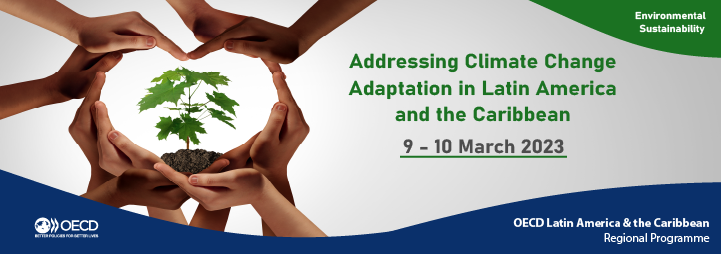Green growth and sustainable development
3rd LAC Regional Policy Dialogue on Environmental Sustainability

The OECD Latin America and Caribbean Regional Programme (LACRP) carried out its 3rd Regional Policy Dialogue on Environmental Sustainability, under the theme “Addressing Climate Change Adaptation in LAC”. The event took place on the 9th and 10th March 2023, from 15:00 – 18:30 CET. The meeting was held as a virtual event.
The Enhancing Green Transition in LAC: From commitments to action project was launched in the context of the new Environmental Sustainability Priority of the LACRP with the support of the European Union. It focuses on supporting the region with evidence-based analysis to address the challenges and opportunities of the Green Transition, as well as identifying policies needed to maximise the potential of this transition for greater well-being.
LAC countries have repeatedly identified climate change adaptation as a key policy priority for the region, as LAC remains one for the top disaster-prone regions in the world, with a high negative impact of climate change and natural hazards to vulnerable and other communities. This Regional Policy Dialogue was an opportunity to:
- Identify and better understand which actions and mechanisms could be adopted, mainstreamed and implemented in the region to strengthen its adaptation capacity to climate change including those related to nature-based solutions;
- Discuss how to best support regional prevention and preparedness actions, including through monitoring and forecasting extreme weather events, and setting early warning systems;
- Exchange on financing climate adaptation responses and prevention measures, as well as on the promotion of relevant investment instruments;
- Propose ways to integrate gender equality considerations in climate change adaptation actions.
Meeting documents
- Agenda and Concept Note
- Meeting presentations (available in ENG/SPA)
kEY MESSAGES
- National Adaptation Plans (NAPs) could help ensure a coherent and whole of government approach, identify and strengthen policy responses to address climate risks, and integrate them into national, local and sectoral development plans and budgets. LAC governments should aim to develop, approve - and those that already did so - vigorously implement their NAPs, as well as local adaptation strategies deriving from them.
- More specifically, mapping and developing climate scenarios can help identify possible vulnerabilities, and losses and damages from climate change. However, measures taken require a coherent approach, whereby climate change adaptation is mainstreamed in sectoral policies, and in the planning and implementation at the sub-national level. Implementation requires reliable data to carry out evidence-based research and support policy choices, adequate financial resources, and a monitoring mechanism to measure vulnerability.
- There is a lot of untapped potential for investments in climate change adaptation, yet there are also challenges to overcome; such as speeding up the disbursement and effectiveness of financial support from international sources, and transforming good ideas into bankable projects. Collaborating with the private sector from the early stages, will allow for better shaping the policy design, and eventually for better results. Addressing multiple issues (mitigation, adaptation, biodiversity loss) under each project could also add value, however there is always a risk of delaying financing or of weakening adaptation action.
- Climate change adaptation has local impacts, affecting communities and vulnerable groups. There is a need for co-ordination and co-operation between national, sub-national and local governments, as well as inclusion of local stakeholders in the discussions when setting and implementing climate adaptation programmes and projects. There is also a need to progress with capacity building at the local level, to enhance access to financing and support mainstreaming adaptation at the local level.
- Biodiversity and nature-based solutions (NbS) can offer numerous benefits in terms of climate change adaptation. There is an increasing commitment to NbS in LAC countries, as they can be cost-effective and provide multiple co-benefits while responding to the impacts of climate change; however, the approach taken is often piecemeal. Countries need to improve their enabling conditions in favour of integrating nature as a set of solutions in combating the impacts of climate change, so that planners, engineers and financers all include nature as part of their toolset in the future. Upscaling NbS further requires better policy design of the instruments and tools, as well as awareness-raising on how to best utilise them; more targeted and coherent funding approaches for NbS projects; and technical capacity at the local level.
- There is a differentiated impact of climate change adaptation on different groups, including women and men. Including gender targets in adaptation planning should be supported by effective institutional arrangements, consultation with different stakeholders, comprehensive policy frameworks, and gender-disaggregated environmental information. Gender ex-ante and ex-post analysis, which integrates women’s role in adaptation policies, and measures positive gender-responsive effects, is crucial.
Meeting Replay videos
| Day 1: Climate change adaptation | Day 2: Thematic approaches to climate change |
Background
The Enhancing Green Transition in LAC: From commitments to action project was launched in the context of the new Environmental Sustainability Priority of the LACRP with the support of the European Union. It focuses on supporting the LAC region with evidence-based analysis to address the challenges and opportunities of the Green Transition, as well as identifying policies needed to maximise the potential of this transition for greater well-being.
- For further information, please contact:
- Dimitra XYNOU (Dimitra.XYNOU@oecd.org).
Related Documents